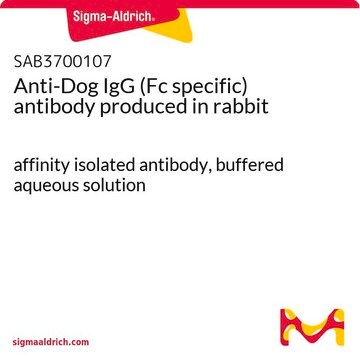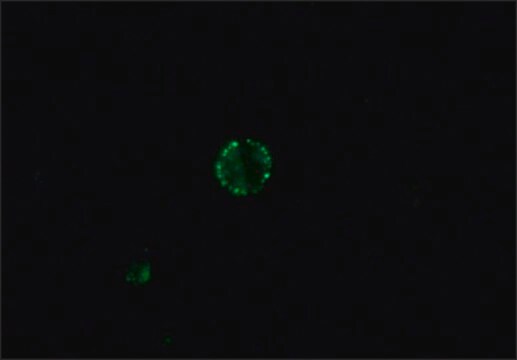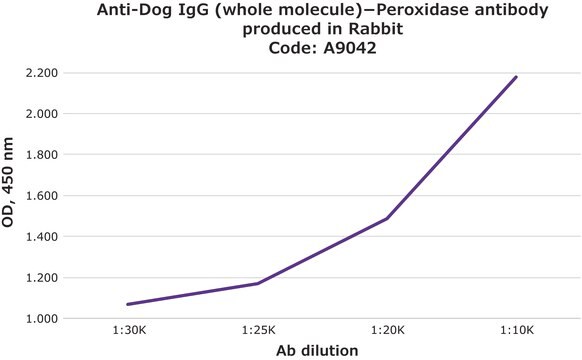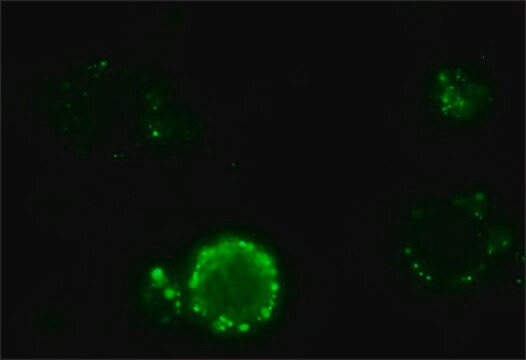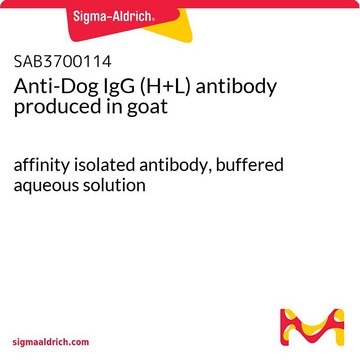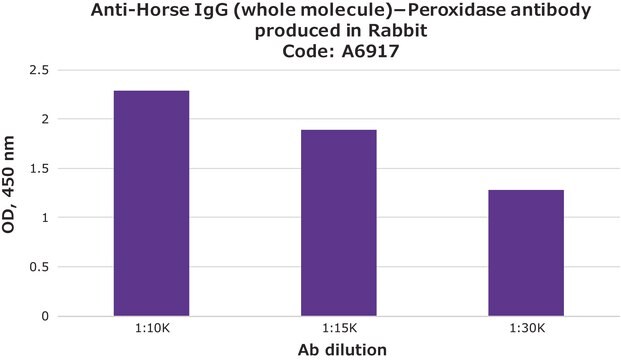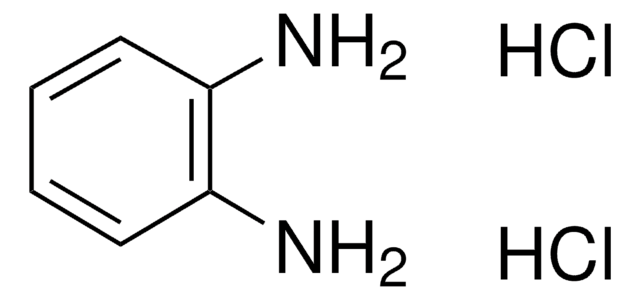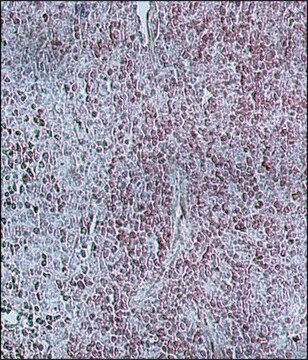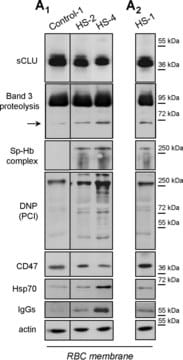A6792
Anti-Dog IgG (whole molecule)−Peroxidase antibody produced in rabbit
affinity isolated antibody, buffered aqueous solution
Synonym(s):
Rabbit Anti-Dog IgG (whole molecule)−HRP
Sign Into View Organizational & Contract Pricing
All Photos(1)
About This Item
Recommended Products
biological source
rabbit
Quality Level
conjugate
peroxidase conjugate
antibody form
affinity isolated antibody
antibody product type
secondary antibodies
clone
polyclonal
form
buffered aqueous solution
technique(s)
direct ELISA: 1:10,000
shipped in
dry ice
storage temp.
−20°C
target post-translational modification
unmodified
Looking for similar products? Visit Product Comparison Guide
Related Categories
General description
IgG (immunoglobulin G) antibody subtype is the most abundant of serum immunoglobulins of the immune system. It is secreted by B cells and is found in blood and extracellular fluids. Mammalian IgG has four subclasses- IgG1, IgG2a, IgG2b and IgG2c.
Specificity of the anti-dog IgG antiserum is determined by immunoelectrophoresis, prior to conjugation, versus normal dog serum and dog IgG.
Application
Anti-Dog IgG (whole molecule) Peroxidase antibody produced in rabbit has been used:
- for the detection of antibodies against noro viruses, by ELISA (enzyme linked immunosorbent asay) at 1:2000 for 1 hour at 37°C
- in IgG (Immunoglobulin G) staining method
- in ELISA to detect the incorporation of RVGTM (a rabies virus G protein variant)
Biochem/physiol Actions
IgG (Immunoglobulin G) antibody provides protection from infections caused by bacteria, fungi and viruses. Maternal IgG is transferred to fetus through the placenta that is vital for immune defense of the neonate against infections. Anti-Dog IgG antibody is a secondary antibody. Second antibodies (secondary antibodies) are raised against primary antibodies, which bind to specific antigens to create antigen antibody complexes.
Physical form
Solution in 0.01 M phosphate buffered saline, pH 7.4 containing 1% bovine serum albumin and 0.05% MIT
Preparation Note
Prepared using the periodate method described by Wilson, M.B., and Nakane, P.K., in "Immunofluorescence and Related Staining Techniques," Elsevier/North Holland Biomedical Press, Amsterdam, p215 (1978).
Legal Information
Ampliflu is a trademark of Sigma-Aldrich Co. LLC
Disclaimer
Unless otherwise stated in our catalog or other company documentation accompanying the product(s), our products are intended for research use only and are not to be used for any other purpose, which includes but is not limited to, unauthorized commercial uses, in vitro diagnostic uses, ex vivo or in vivo therapeutic uses or any type of consumption or application to humans or animals.
Not finding the right product?
Try our Product Selector Tool.
Signal Word
Warning
Hazard Statements
Precautionary Statements
Hazard Classifications
Skin Sens. 1
Storage Class Code
12 - Non Combustible Liquids
WGK
WGK 2
Flash Point(F)
Not applicable
Flash Point(C)
Not applicable
Choose from one of the most recent versions:
Already Own This Product?
Find documentation for the products that you have recently purchased in the Document Library.
Customers Also Viewed
I F G de Amorim et al.
Veterinary parasitology, 173(1-2), 55-63 (2010-07-20)
Dogs represent the major reservoir of Leishmaniao chagasi and vaccination against the canine disease is a potential control strategy. However, seroconversion occurs post-vaccine and hence, there is need to discriminate between the former group and naturally infected dogs. The present
Maria M Figueiredo et al.
BMC immunology, 14, 22-22 (2013-05-15)
Infection with parasite protozoa is a long-term health issue in tropical and subtropical regions throughout the world. The Toll-like receptor (TLR) signaling pathway is one of the first-responding defense systems against Leishmania. The aim of this study was to investigate
Chimeric rabies glycoprotein with a transmembrane domain and cytoplasmic tail from Newcastle disease virus fusion protein incorporates into the Newcastle disease virion at reduced levels
Yu GM, et al.
Journal of Veterinary Science, 18(S1), 351-359 (2017)
Vivian Tamietti Martins et al.
PloS one, 10(9), e0137683-e0137683 (2015-09-15)
In the present study, two Leishmania infantum hypothetical proteins present in the amastigote stage, LiHyp1 and LiHyp6, were combined with a promastigote protein, IgE-dependent histamine-releasing factor (HRF); to compose a polyproteins vaccine to be evaluated against L. infantum infection. Also
Lukas Uhrik et al.
The Biochemical journal, 478(1), 99-120 (2020-12-08)
A comparative canine-human therapeutics model is being developed in B-cell lymphoma through the generation of a hybridoma cell that produces a murine monoclonal antibody specific for canine CD20. The hybridoma cell produces two light chains, light chain-3, and light chain-7.
Our team of scientists has experience in all areas of research including Life Science, Material Science, Chemical Synthesis, Chromatography, Analytical and many others.
Contact Technical Service